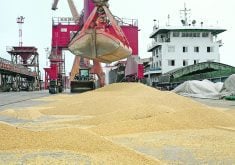It can be misleading for farmers to draw conclusions by comparing port prices to those at their local elevator, says an analyst.
Delegates attending Alberta Wheat Commission’s annual meeting passed a resolution calling on the commission to lobby the provincial and federal governments to require grain companies to report international sales prices.
“Personally, I don’t favour reporting actual sales prices at the port because that’s competitive (information) and should be confidential,” said FarmCo president John De Pape, whose company compiles grain and oilseed prices for the commission.
Read Also

Flax sector sees omega-3 opportunity
SASKATOON — A global shortage of omega-3 oils could be an opportunity for the flax sector, says an industry official….
De Pape believes publishing the information would hurt Canada’s reputation as a grain exporter.
“If I was a buyer of Canadian grain, I wouldn’t want the world to know what I’m buying for f.o.b. Vancouver,” he said.
“If we were to do that we would be the only one in the world doing it and it would be bad for business.”
He also has concerns about how farmers would use the information because it can lead to misleading conclusions about grain company margins.
That is because of a timing issue. People comparing the port price at a point in time to an inland price are working under the false assum-ption that grain companies are selling the grain the same day they buy it.
The reality is they are likely sourcing grain to fill an order that was made months ago.
Some people are already drawing conclusions about grain company margins by comparing weekly port price information provided by Agriculture Canada to daily country prices published on the commission’s Price and Data Quotes website PDQinfo.ca.
Comparing the Agriculture Canada weekly Vancouver port price to the PDQinfo.ca cash price for Jan. 15 for southeastern Saskatchewan showed No. 1 CWRS 13.5 percent protein wheat spread at about $82 per tonne, No. 1 durum at about $105 per tonne and canola at $49 a tonne.
Agriculture Canada’s weekly port price summary uses International Grain Council and industry information providing a sample of free on board asking prices for export. It says the prices are believed to be accurate, but concedes the prices might not be reflective of actual selling prices.
De Pape said it is dangerous to compare a weekly number to a cash price from a single day be-cause prices fluctuate.
A better comparison would be to compare basis levels at the port to those in the country.
“Then you get the futures variation out of the calculation,” he said.
If the cash price in the country was $30 per tonne under the futures price and the cash price at the port was $20 over, then the spread would be $50. The problem is there are no published cash prices at the port.
De Pape also questions the motivation behind the demand for increased transparency, mainly that farmers want to know if they are being gouged by the grain companies.
“I have a slightly different view from most farmers,” he said.
“When the spread between the country and the port is wide like it has been, that tells me we have more grain that wants to use the system than the capacity would allow.”
De Pape doesn’t believe that constitutes gouging.
“(Grain companies) are reacting to the fact that farmers want to deliver. They’ve got this pressure coming up, so they will lower their prices,” he said.
















